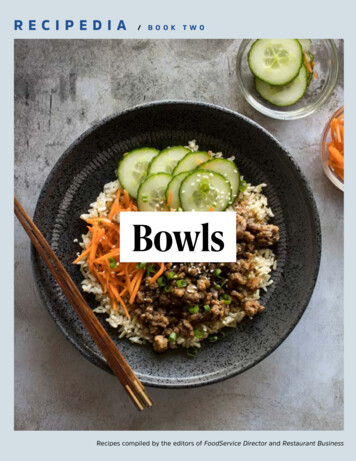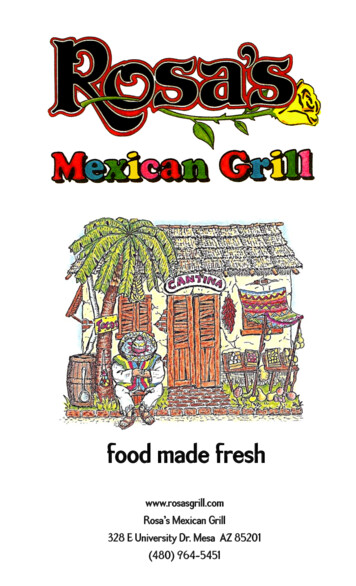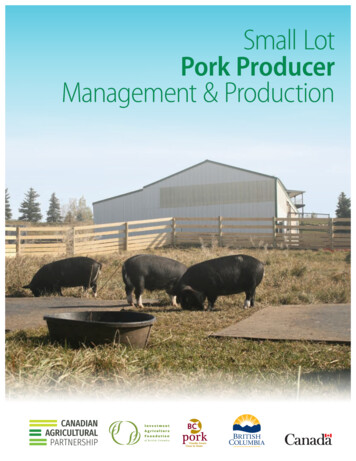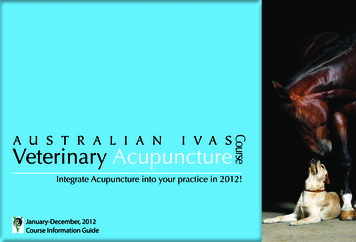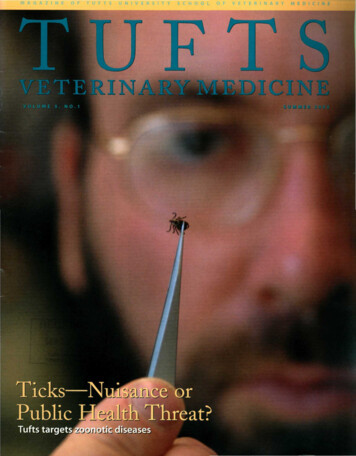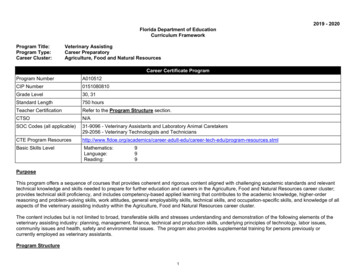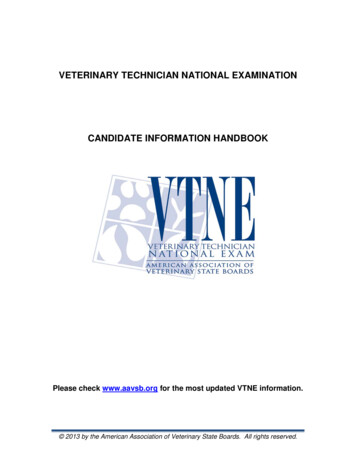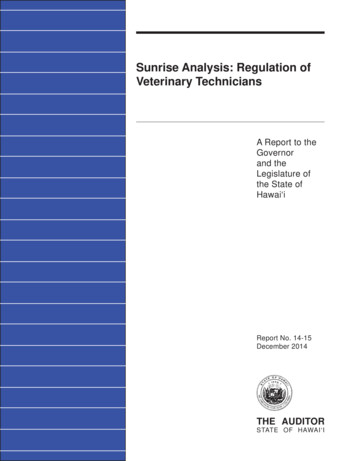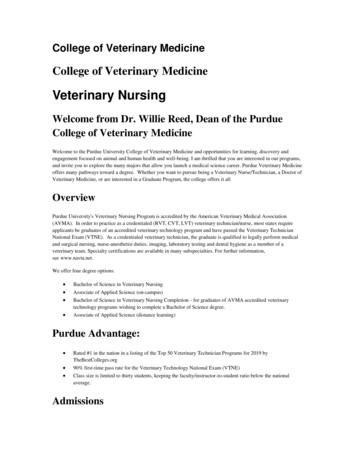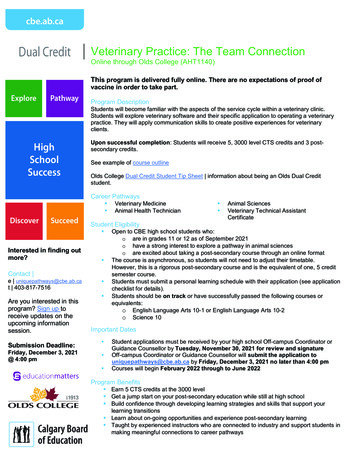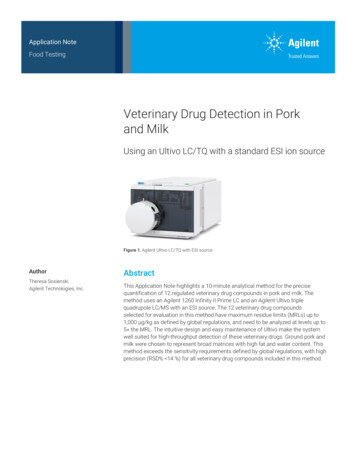
Transcription
Application NoteFood TestingVeterinary Drug Detection in Porkand MilkUsing an Ultivo LC/TQ with a standard ESI ion sourceFigure 1. Agilent Ultivo LC/TQ with ESI source.AuthorTheresa SosienskiAgilent Technologies, Inc.AbstractThis Application Note highlights a 10-minute analytical method for the precisequantification of 12 regulated veterinary drug compounds in pork and milk. Themethod uses an Agilent 1260 Infinity II Prime LC and an Agilent Ultivo triplequadrupole LC/MS with an ESI source. The 12 veterinary drug compoundsselected for evaluation in this method have maximum residue limits (MRLs) up to1,000 µg/kg as defined by global regulations, and need to be analyzed at levels up to5 the MRL. The intuitive design and easy maintenance of Ultivo make the systemwell suited for high-throughput detection of these veterinary drugs. Ground pork andmilk were chosen to represent broad matrices with high fat and water content. Thismethod exceeds the sensitivity requirements defined by global regulations, with highprecision (RSD% 14 %) for all veterinary drug compounds included in this method.
IntroductionVeterinary drugs are mainly used inlivestock to prevent diseases andparasites, and promote growth.Improper use of veterinary drugs inlivestock operations can result in theaccumulation of these drugs in animaltissues and other animal-derived foodssuch as milk or eggs. Because of globalconcern for the presence of veterinarydrugs in livestock products for humanconsumption, an AOAC working grouprecently proposed Standard MethodPerformance Requirements (SMPRs)for an extensive list of veterinary drugcompounds. These included detectionlimits based on US1, Codex2, China3, andCanada4 regulations for veterinary drugresidues in meat and milk. Detection limitrequirements were proposed at half theMRL with the lowest MRL between theregulatory agencies always being chosenas the default.The 12 veterinary drugs included in thismethod represent a group of veterinarydrugs that have relatively high MRLsin milk and meat. The veterinary drugcompounds each have target testinglevels, defined as 1/2 the MRL of thecompound. The target testing levelsof the 12 studied compounds rangefrom 22.5–100 µg/kg in milk and from50–500 µg/kg in meat (Table 1). TheUltivo triple quadrupole LC/MS with astandard ESI source can be the perfectsystem for such measurements.This Application Note demonstrates theprecise quantification of 12 regulatedveterinary drug compounds in pork andmilk using a 1260 Infinity II Prime LCand an Ultivo LC/TQ equipped with anESI source. The Ultivo-ESI inherited theoutstanding performance of Ultivo.2Table 1. Target testing levels of the 12 veterinary drugs in milk and meat.Milk target testinglevel (µg/kg)Meat target testinglevel etracycline5050CompoundExperimentalReagents and chemicalsAll reagents used were HPLC or LC/MSgrade. Acetonitrile and methanol werepurchased from Honeywell (Morristown,NJ, USA), and ultrapure water wassourced from a Milli-Q Integral Systemwith a LC-Pak Polisher and a 0.22-µmpoint-of-use membrane filter cartridge(EMD Millipore, Billerica, MA, USA).Formic acid was purchased from FisherScientific (Fair Lawn, NJ, USA), andammonium fluoride (solid powder) waspurchased from Aldrich (Sigma-AldrichCorp., St. Louis, MO, USA), a 5 M stocksolution was made. Veterinary drugstandards were also purchased fromSigma-Aldrich.Sample preparationFresh 2 % pasteurized organic milkand antibiotic-free ground pork(80 % lean, 20 % fat) were obtainedfrom local grocery stores. Samplesof 2 g of pork or milk were weighed in50-mL polypropylene tubes, and frozenuntil analysis. The sample preparationprocedure for pork was sourced froma method previously evaluated byZhao; et al.5. The method was furthermodified for the milk extraction, andis summarized in Figure 2. A HeidolphHei-MIX Multi Reax system was usedto vortex the samples. Agilent CaptivaEMR–Lipid cartridges, 6 mL, 600 mg(p/n 5190-1004) were used in thefinal cleanup of the pork extraction.Captiva EMR—Lipid cartridges provideefficient and selective lipid removal withexceptional recovery of hydrophobicanalytes.
MilkPorkWeigh 2 g of milk into a 50-mLcentrifuge tube.Weigh 2 g of pork into a 50-mLcentrifuge tube.Add 400 µL 0.5 M EDTA solution.Add 2 mL of 0.1 M EDTA solution and twoceramic homogenizers to the pork.Shake supernatants for 5 minuteson a vortex shaker.Shake for 5 minutes on a vortex shaker.Shake for 5 minutes on a vortex shaker.Centrifuge the supernatants at4,500 rpm for 5 minutes.Add 7.6 mL of acetonitrile with2 % formic acid and 2 % DMSO.Centrifuge at 4,500 rpm for 5 minutes,then transfer the supernatant.Transfer 5 mL of supernatant to aCaptiva EMR—Lipid cartridge, allowgravity elution, then collect the eluate.Shake for 5 minutes on a vortex shaker.Add 8 mL of acetonitrile with2 % formic acid and 2 % DMSO.Centrifuge at 4,500 rpm for 5 minutes.Shake for 5 minutes on a vortex shaker.Combinesupernatants in a15-mL centrifugetube.Add 1.25 mL of 80:20 acetonitrile/watersolution, and apply gentle vacuum untilno liquid remains in the cartridge.Transfer the eluate to an LC vial.Transfer the supernatant to an LC vial.Centrifuge at 4,500 rpm for 5 minutes,then transfer the supernatant.Figure 2. Sample preparation procedure for veterinary drugs in pork and milk.InstrumentationAgilent 1260 Infinity II Prime LC 1260 Infinity II Prime flexible pump(G7104C) 1260 Infinity II multisampler withcooler (G7167A) 1260 Infinity II multicolumnthermostat (G7116A)Table 2. Agilent 1260 Infinity II Prime LC parameters.ColumnAgilent InfinityLab Poroshell 120 EC-C8, 2.1 100 mm, 2.7 µm(p/n 695775-906)Column temperature40 CObserved column backpressure range170–370 barInjection volume4 µLMobile phaseA) 0.2 % Formic acid in waterB) 0.5 mM Ammonium fluoride in methanolFlow rate0.350 mL/minGradientTime (min)01.52.55.07.07.19.0Stop time9.0 minutesPost time1.0 minutesAgilent Ultivo triple quadrupole LC/MSsystem Electrospray ionization source(G1948B)MethodTable 2 summarizes the 1260 Infinity IIPrime LC conditions, and Table 3summarizes the Ultivo ion source andinstrument parameters. Table 4 showsthe optimized MS parameters for thecompounds of interest. Dynamic multiplereaction monitoring (dMRM) wasused for data collection. MassHunterQuantitative Analysis software B.09 withthe Quant-My-Way feature was usedto accelerate and streamline the dataanalysis and review process.%B227010010022Table 3. Ultivo ion source and massanalyzer parameters.Gas temperature325 CGas flow8 L/minNebulizer pressure40 psiCapillary voltage2,000 V ( )Cycle time500 ms3
Experimental designPork and milk spiked after the extractionprocedure (post spiked) were used forthe sensitivity, precision, and linearitystudies. For recovery evaluation, porkand milk were spiked with a stocksolution of veterinary drugs beforeextraction (prespiked), and compared topost spiked pork and milk extracts forrecovery (%) calculations after analysis.Table 4. Optimized transitions for veterinary drug detection in dynamic MRM mode.Precursor(m/z)Product(m/z)RT(min)RT 11304PositiveMethod sensitivity and eAll veterinary drugs could accuratelybe quantified at 1/2 MRL, while mostcould be quantified at 1/10 MRL, thelowest level tested in this study. Figure 3shows the excellent signal response forall analytes at the target testing levelin pork extract. The veterinary drugsalso showed excellent precision at thelowest testing level, with RSD% below14 % for all compounds tested, alongwith each compound’s lowest testinglevel, as shown in Table 5. Accuratequantification at the lowest testing levelwas defined as having four out of sixreplicate injections with accuracy of80–120 %, and a signal‑to-noise ratio(S/N) greater than 10 for both quantifiersand qualifiers. Several veterinary drugcompounds had a very strong signalresponse at 1/10 MRL, indicating that thequantitation limit is considerably lowerthan 1/10 MRL (a few examples areincluded in Figure ositiveResults and el662.9194.17.290.818080Positive
1041.3Fenbendazole1.2 1017.0 .53.02.52.01.51.00.500.5 0.6 0.7 0.8 ycline0.3Diminazine0.2Ceftiofur0.1Novobiocin00.4 0.6 0.8 1.0 1.2 1.4 1.6 1.8 2.0 2.2 2.4 2.6 2.8 3.0 3.2 3.4 3.6 3.8 4.0 4.2 4.4 4.6 4.8 5.0 5.2 5.4 5.6 5.8 6.0 6.2 6.4 6.6 6.8 7.0 7.2 7.4 7.6Acquisition time (min)Figure 3. Chromatogram of veterinary drug analytes spiked into pork extract at the target testing level (1/2 MRL).Table 5. Lowest testing level and precision for all veterinary drugs studied in pork and milk extract. All couldaccurately be quantified at or below the target testing level (1/2 MRL).MilkCompoundStreptomycinLowest testing level (µg/kg)PorkRSD% (n 6)1/2 MRL62.513.74Dihydrostreptomycin1/2 MRL62.5Diminazine1/10 MRL15Lincomycin1/10 MRLTetracycline1/10 MRLOxytetracyclineSpiramycinLowest testing level (µg/kg)RSD% (n 6)1/5 MRL1006.927.761/5 MRL1006.525.791/10 MRL503.74152.021/10 MRL100.83103.261/10 MRL103.481/10 MRL104.161/10 MRL103.601/10 MRL204.341/10 MRL205.39Chlortetracycline1/10 MRL103.381/10 MRL103.46Ceftiofur1/10 MRL1011.561/10 MRL1002.22Fenbendazole1/10 MRL101.101/10 MRL101.26Novobiocin1/5 MRL1010.931/10 MRL1004.13Closantel1/10 MRL4.54.751/10 MRL1003.605
Milk4.866 min.5.04.54.0 MRM (407.2 & 40.30.20.10-0.14.768 min.CountsCounts3.5 10 MRM (300.1 & 268.1)2.85.969 02.52.01.51.00.50-0.5 10334.6 4.7 4.8 4.9 5.0 5.1 5.2Acquisition time (min)4.44.64.85.05.2Acquisition time (min) MRM (662.9 & 264.0)0.97.263 min.0.80.70.6Counts 10 MRM (461.2 & 426.0)5.5Pork3Counts 1020.50.40.30.20.107.0 7.1 7.2 7.3 7.4 7.5 7.6Acquisition time (min)5.7 5.8 5.9 6.0 6.1 6.2 6.3Acquisition time (min)Oxytetracycline in milkLincomycin in milkFenbendazole in porkClosantel in pork1/10 MRL & 10 µg/kgPeak area: 3095S/N: 2,3541/10 MRL & 15 µg/kgPeak area: 12237S/N: 7871/10 MRL & 15 µg/kgPeak area: 15068S/N: 1141/10 MRL& 100 µg/kgPeak area: 4920S/N: 878Figure 4. Select veterinary drug compounds with strong signal response at 1/10 MRL, indicating that the quantitation limit is much lower than 1/10 MRL.All veterinary drugs showed goodlinearity with 1/x weighting, and allcalibration curves have R2 values greater41.20.81020 30 40 50 60Concentration (ng/mL)70Milk0800 102.01.81.61.41.21.00.80.60.40.20204060CeftiofurR2 0.998Range: 16–800 µg/L54321Pork00100 200 300 400 500 600 700 8007654321080 100 120 140 1604ChlortetracyclineR2 0.999Range: 1.6–80 µg/LMilk0 R2 0.999Range: 3.2–160 µg/L7080ChlortetracyclineR2 0.999Range: 1.6–80 µg/LPork020406080 100 120 140 160Pork01020304050Figure 5. Select calibration curves of veterinary drugs spiked into pork and milk matrices at concentrations ranging from 1/10 MRL to 5 MRL.6604ResponseResponse61.60.4Milk0 1072.0 104SpiramycinR2 0.999Range: 3.2–160 µg/LResponse0.90.80.70.60.50.40.30.20.10 1042.4CeftiofurR2 0.998Range: 1.6–80 µg/LResponseResponse 104than 0.98. Calibration levels ranged from1/10 MRL to 5 MRL for all analytes.Figure 5 shows examples of some of thecalibration curves.ResponseMethod linearity607080
Method recoveryrecovery was between 60 and 120 %at all levels in both matrices (Figure 6).Dihydrostreptomycin and streptomycinhad poor recovery with this extractionmethod, but could be detected at orbelow the target testing level (1/2 MRL)in post spiked matrix. For these twoThe recovery of all veterinary drugswas evaluated in both milk and porkat three levels: 1/2 MRL, MRL, and2 MRL. Six replicates of each spikinglevel were evaluated in the recoverystudy. For 10 of the compounds, thevery hydrophilic compounds, a differentextraction method may be used, butthis analysis method is suitable forscreening. For accurate quantitation,internal standards should be used tocorrect the loss of these two compoundsduring extraction.1/2 MRLMRL2X eRecovery (%)A 150Veterinary drug compound1/2 MRLMRL2X ery (%)B 130Veterinary drug compoundFigure 6. Recovery of veterinary drugs in milk (A) and pork (B) at 1/2 MRL, MRL, and 2 MRL spiking levels. Error bars denote the standard deviation of sixreplicates. Dihydrostreptomycin and streptomycin are not included.7
ConclusionsReferencesThe use of an Ultivo triple quadrupoleLC/MS equipped with an ESI ion sourceexceeded the MRL requirements set byglobal regulatory agencies for veterinarydrugs in meat and milk, with excellentprecision. Captiva EMR–Lipid cartridgesprovided adequate extra cleanup ofthe fat-laden pork matrix, assisting themethod sensitivity. The 1260 Infinity IIPrime LC was a perfect separation toolfor the low backpressure observed withthis method. In applications where thesensitivity requirements can be relaxed,this configuration of Ultivo with an ESIsource is an excellent fit-for-purposechoice.1.Department of Health andHuman Services, Food and DrugAdministration, 21 CFR Parts 514and 558, FDA-2010-N-0155.2.Proposal for a regulation of theEuropean Parliament and of thecouncil on veterinary medicinalproducts, European Commission,2014/0257 (COD).www.agilent.com/chemThis information is subject to change without notice. Agilent Technologies, Inc. 2018Printed in the USA, December 13, 20185994-0480EN3.Maximum Residue Limits in animalderived foods, Announcement No.235, Ministry of Agriculture, China,2002.4.List of Maximum Residue Limits(MRLs) for Veterinary Drugs inFoods, Health Canada, Governmentof Canada. August 2, 2017. hc-sc/dhp-mps/alt formats/pdf/vet/mrl-lmr/mrllmr versus new-nouveau-20170802eng.pdf5.Zhao, L.; Lucas, D. MulticlassMultiresidue VeterinaryDrug Analysis in Beef UsingAgilent Captiva EMR–LipidCartridge Cleanup and LC/MS/MS.Agilent Technologies ApplicationNote, publication number5991‑8598EN, 2017.
Quantitative Analysis software B.09 with the Quant-My-Way feature was used to accelerate and streamline the data analysis and review process. Figure 2. Sample preparation procedure for veterinary drugs in pork and milk. Table 2. Agilent 1260 Infinity II Prime LC parameters. Column Agilent InfinityLab Poroshell 120 EC-C8, 2.1 100 mm, 2.7 µm

